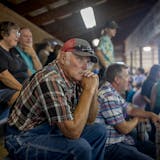At least two of the three semifinalists for the University of Minnesota president job have told the U's governing board they are willing to be named finalists — and go public with their identities — only if they are the sole front-runner for the position.
That places university regents in a delicate position going into a Wednesday meeting to make decisions on finalists: They will be forced to rally around a single finalist to interview publicly — or scrap what board members generally agree are strong contenders recommended by the U's 23-member search committee.
Some regents say they are uncomfortable with advancing only one finalist and even question if a do-over of the search process is in order. Faculty and others have also called for a chance to vet multiple candidates publicly.
But other regents said they believe the search process has worked well and produced stellar semifinalists. They said it is understandable that high-profile candidates, particularly sitting university presidents, would balk at going public, which could sour their relationships with their own governing boards, donors and lawmakers.
All board members said they are intensely conscious of the high stakes as the search enters its decisive final stretch.
"It's the most important decision we as regents make: Who will be captain of this ship?" said Regent Dean Johnson, one of four regents who spoke Tuesday about facing the prospect of having a sole finalist.
Some search process critics said Tuesday that they are disappointed the board might be headed for a reprise of the search that brought in President Eric Kaler, himself a sole finalist for the position in 2010. They criticized a plan to hold off on naming any finalists until Thursday morning though their identities technically become public when the board picks them as finalists Wednesday afternoon.
In September, the university launched a fast-paced, 12- to 16-week national search to replace Kaler, who is stepping down next summer. The search drew 67 applicants, and the search committee made up of faculty, staff, students and others interviewed five women and four men to narrow the list to three.


